HTC One max Review - It's Huge
by Brian Klug on October 28, 2013 10:00 AM EST- Posted in
- Smartphones
- HTC
- Mobile
- One
- Snapdragon 600
- Android 4.3
- One max
Battery life remains a huge concern for savvy smartphone shoppers. Opportunistically charging a phone and worrying about making it through an entire day with just a single charge cycle is a common complaint as well. The HTC One max addresses some of the complaints myself and others had with charging on the HTC One which charged at only 1 amp, instead the One max charges at up to 1.5 amps. Although I wasn’t sampled it, the One max box will also include a 1.5 amp charger from HTC that’s slightly taller than the previous generation. This definitely helps offset the increase in charge time that would’ve resulted given the 43 percent larger 3300 mAh 3.8V (12.54 watt hour) battery.
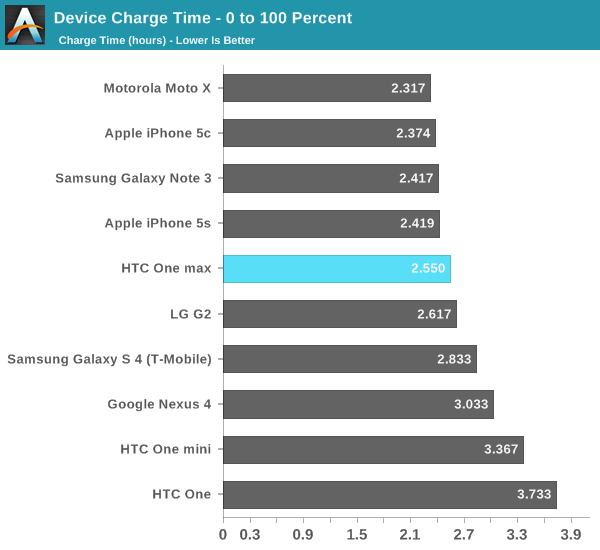
The HTC One charges a bit faster with the latest updates, however the linear region of the charge curve is entirely dominated by that 1 A charging maximum. With the 1.5 A charging in the One max we actually see considerably faster charge times in spite of the larger battery. HTC continues to use BC 1.2 to the best of my knowledge for signaling.
To assess battery life, I ran the One max through our battery life test suite. Our battery life test is unchanged, we calibrate the display to exactly 200 nits and run it through a controlled workload consisting of a dozen or so popular pages and articles with pauses in between continually, until the device dies. This is repeated on cellular and WiFi, in this case since we have an international model of the One max that lacks the LTE bands used in the USA, that’s 3G WCDMA on AT&T’s Band 2 network. The talk time call test is self explanatory and also unchanged.
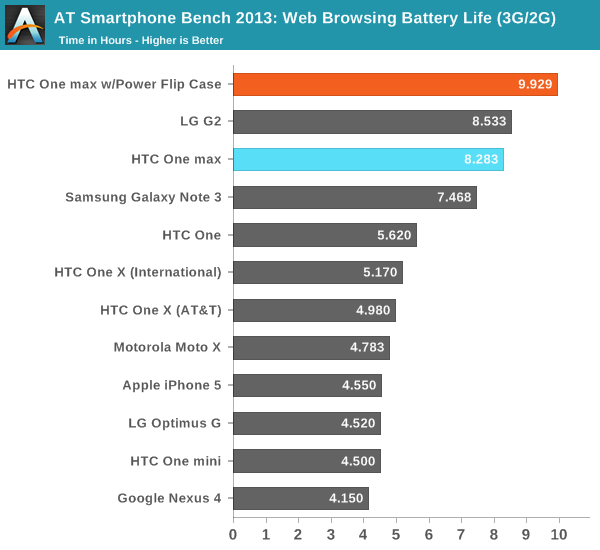
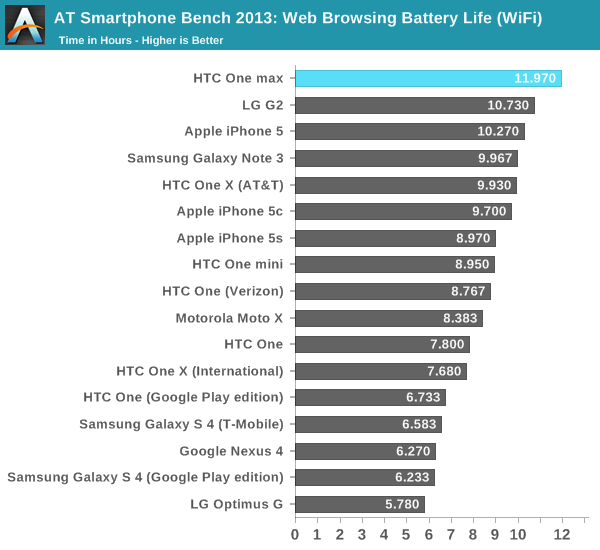
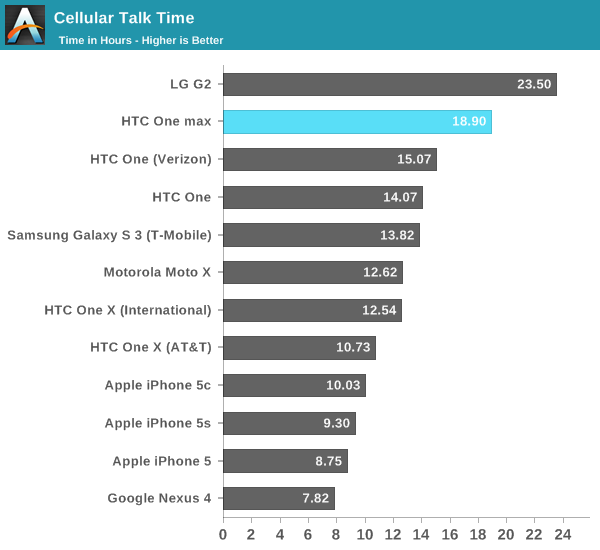
The results speak for themselves, the One max lasts quite a long time on battery, even with a large display. I expected the One max to lose to the Note 3 on the cellular test initially, but it posts an impressive result. I suspect display power might be the reason here between AMOLED and the more pragmatic LCD in the One max. I measured the One max with the flip case on as well, and it adds about 20 percent more battery time to the device. I'm curious to see how the USA-bound variants with LTE fare, but the One does impress with excellent battery life.


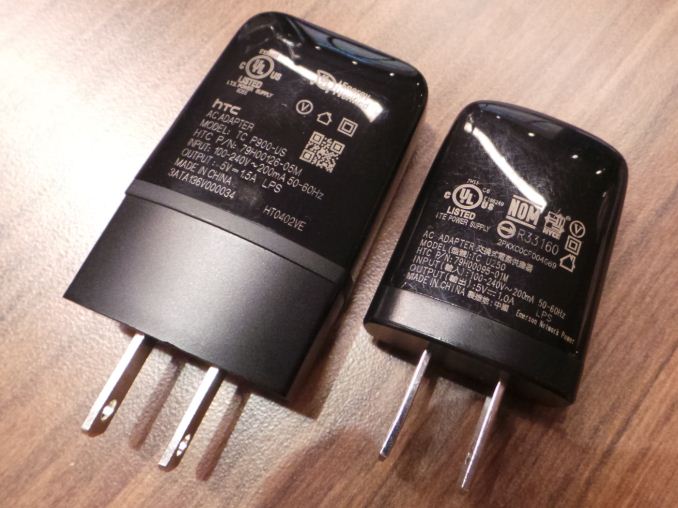








197 Comments
View All Comments
Steven JW FCK - Monday, October 28, 2013 - link
How can you say a "very tiny part of the market" and know for certain? I know so many Samsung smartphone users, and do you want to know how many of them have been asked by Samsung how they use there micro SD cards, and the data storage facilities on their phones?NONE OF THEM!
So where on earth are you pretending to get your data from? And how exactly are you interpreting the numbers? I just fail to believe you actually know the ins and outs of phone storage and micro SD card usage in smartphones upon a broad enough scale to start making allegations like you have.
Believe the reality you want, it only exists in a very small and exceptionally annoying minority.
rabidkevin - Tuesday, October 29, 2013 - link
Bullshitsuperflex - Tuesday, October 29, 2013 - link
Agreed.Someone need to grease their gears. Their screech is annoying and not supported by a vast majority.
lazymangaka - Monday, October 28, 2013 - link
I don't understand the the reviewer's hatred of MicroSD cards. They're a useful thing to have, for every type of user. And, the fact of the matter is, internal storage space has not been rapidly increasing in smartphones. Storage needs have, however. Unlimited data plans are gone for many users, so listening to locally-stored music makes much more sense. In addition to that, the megapixel count of smartphone cameras continue to march north, and those larger file sizes are competing with ever-increasing app sizes. MicroSD expansion just makes sense.I understand what Google was trying to do in nixing external expansion in its Nexus lineup, but it just hasn't played out the way they wanted it to. Instead of getting a phone with 16GB of internal storage and an external expansion slot, we're more likely to just get a phone with 16GB of internal storage. Campaigning for the continued removal of MicroSD storage is doing nothing but harming us all.
Mondozai - Monday, October 28, 2013 - link
Lazumangaka:"I don't understand the the reviewer's hatred of MicroSD cards."
Every reviewer have their irrational foibles that makes no sense. You just have to learn those blindspots and avoid them like the plague with each particular reviewer.
With Brian we know he hates WP8, he dislikes microSD cards and he winces on AMOLED screens. He still puts out very qualified reviews but again, know when to listen, and when to just skip.
Brian Klug - Monday, October 28, 2013 - link
Luckily it's easy to back up the dislikes of microSD (poor Android support, slower than native storage, tradeoffs in build quality) and AMOLED screens (oversaturated, higher power drain, burn in, and sensitive to overheating), and reasons why I can't get anything done on WP8. They aren't blind spots that make no sense, they're just realities.-Brian
PC Perv - Tuesday, October 29, 2013 - link
What an arrogant hoax. You surely realize that every point you raise has counter points, right?How about being on consumer side for once? Make a case why 32 GB should be the bottom line. And why 64 GB should cost $20 more, not $100 more, etc,. Stop worrying about OEMs. They are doing fine. Think for once from consumers standpoint, instead of corporate-hired marketeering.
rabidkevin - Tuesday, October 29, 2013 - link
Hello apple paid spokepersonsuperflex - Tuesday, October 29, 2013 - link
Hello Samsung ShillDentons - Tuesday, October 29, 2013 - link
You're displaying confirmation bias, writ large.We can all find window dressing to support our opinions. That's why so many here object to your rants on AMOLED, microSD, and batteries. Despite your technical expertise, we realize your opinions in those areas has little basis in truth, and is largely just an smug opinion.
Yes, the NAND on many microSD cards is inferior to NAND built into devices. We know and we Don't Care! We use it to hold mass media, videos, photos, and music. What we care about far more is that microSD is often 10 times more cost effective and functions very well indeed.
Really Brian, telling users they really don't need the features they use and love is the height of contemptuous arrogance.